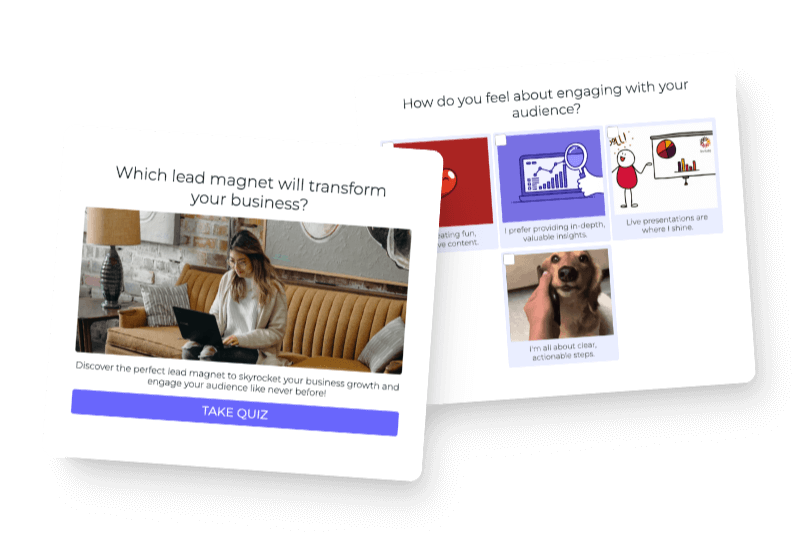
Build your list with a quiz
Generate warm leads who already know your brand
Too many content creators focus on building a strong social media presence instead of prioritizing their list building efforts.
Gaining more social media followers is great, but what if I told you that email subscribers can be worth as much as 15 times more than social media followers in terms of revenue?
Now I’ve got your attention!
Building an engaged email list for your business is one of the best decisions you can make because it gives you a direct line of communication with your most loyal audience members. While it’s unlikely that Instagram and Facebook will be gone tomorrow, you never know when they may disappear or change.
Think about the influencers who made their income from posting Vine videos. When Vine dissolved, they had to quickly find a way to engage with their followers on other platforms before it was too late. The smartest Vine influencers had already been building a fan base on other platforms so their eggs weren’t all in one basket, so to speak.
The same is true for content creators. List building strategies help us create a community of people who are interested in hearing from us and receiving our valuable content.
When someone gives you their email address, it’s worth more than them following you on social media. On Facebook, only two percent of people who like your Facebook business page will organically see your high-quality content! With email marketing, you can ensure that your emails are delivered to all of your email subscribers. You no longer have to worry about low visibility or changing algorithms.
What is an email list?
Your email list is a platform you own, meaning you have complete creative freedom and flexibility with it. You can send any form of content—whether you’re launching a sale or publicizing an event, for example—whenever you want to. If you rely on social media to create buzz, many people will miss your announcement.
Having an email list is a great long-term client retention strategy for all kinds of businesses. Life coaches, fitness trainers, nutrition experts, personal finance educators, e-commerce businesses, and freelancers can all start gathering emails early on.
Read more on how coaches and freelancers can grow their email list through our six-step guide.
If you’re convinced that list building is the right move for your brand, shift your focus to the list building strategies you need to build your email list the right way.
What is email list building?
Email list building is your gateway to building lasting relationships with the people who have shown interest either in your services or the topics you talk about. The process is simple but requires input from both parties: you offer something a potential client might be interested in and ask for their email address in return.
This way, an email list becomes your go-to database of contacts. Here you can store your leads, prospects, and even current or past clients. The purpose of building such an email list of prospects is to retarget them in the future, keeping them up-to-date with your business and new offers.
You can use your newly expanded email list for:
- Sending top-of-the-funnel content to educate people on a topic in which they’ve previously displayed interest
- Loyalizing clients and getting them to both come back for your services and recommend them to their peers
- Positioning yourself as a thought leader in your field through regular educational newsletters
- Announcing discounts, giveaways, and events
- Sharing exclusive content you wouldn’t otherwise host on your blog
- Bringing prospects back to your website for increased traffic
Why do you need an email list for internet marketing?
Email marketing is a more personal way of reaching out to prospects compared to other marketing methods such as content marketing, PPC, or social media. You can mention a person’s name, send targeted emails that suit their exact needs, and be present where they spend a big chunk of their time: their email inbox.
In fact, all stats show that people prefer relevant and customized emails, regardless of the generation they belong to. And if you think that too much personalization is going to put off prospects, it’s time to reconsider. A simple customized subject line can increase open rates by as much as 26 percent.
Talking to a brand or professional via email builds customer trust. You’re entering the private space of their inbox and, if you can provide high-quality resources regularly, you’re there to stay.
In return, you’re not gaining just one more sale or customer. You’re getting insights into how prospects think and behave, what their preferences are, even what types of content they don’t like receiving.
Any email service provider software can give you analytics insights, like the content subscribers enjoy and the times when they’re most active. You can use this information for marketing efforts outside of the email realm to schedule posts, run ads, or create evergreen blog articles people are more likely to read.
This is perhaps the most powerful aspect of having a solid email list: you’re gaining daily know-how into your audience so you can target potential customers exactly how, when, and where they want. After all, email itself is one of the leading targeted marketing tactics you can apply with minimal resources.
Most email service providers offer small businesses these analytics tools for free, until they reach a higher number of subscribers. The return of investment is huge as you are the sole owner of your email list.
So, if you’re short on time, why not put more effort into your email marketing plan and less into raising vanity metrics like social media followers?
We talked to other senior email marketers to get their input on why they started a newsletter in the first place and what mistakes they recommend you avoid in the process:
“We’re using email lists to build a strong pipeline of targeted individuals we can build a relationship with and consistently promote our main product to.
Our main email newsletter shares valuable research, opinion, and advice first and foremost. This ensures our subscribers get value from the email, giving them a reason to open it. It also subtly and organically points subscribers in the direction of our main product.
So the email acts as both lead capture (because our subscribers want the information we share in it) and converter (because our main product is a tool made for our typical subscribers).
I think there are two main mistakes people make when it comes to their email lists:
1. They don’t provide value. You need to do this before you can hope to sell. There has to be a reason for someone to open the email before your sales message can be effective. If your email fails to deliver value, then people will either unsubscribe or simply never open it, and what use is that list then?
2. They aren’t focusing on targeting the right people. Not enough work has been done to find out who they really want as subscribers to their email. A list full of the wrong people has no value for them or for you.” — James Tennant, Founder @Converge
“I consider my email lists invaluable assets because they’re the only way for me to maintain a direct, future-proof relationship with my audience. My subscribers know me and trust me, so they are way more inclined to buy my products than random strangers who see an ad on social media. One cool way I use my email lists is to validate the demand for new paid products by asking for feedback before I invest too much time creating something nobody wants.
Make sure you focus on the number of unique opens you get instead of list size. Clean your list periodically and remove inactive subscribers to increase deliverability. Talk to your subscribers and encourage them to reply and create meaningful conversations.” — Andrea Bosoni, Founder @Zero to Marketing
“Often, those who sign up for our email lists are people who’ve visited our website. They found our blogs or content offers interesting enough to give us their email addresses so they can stay up-to-date with our content. This makes them warm leads.
Once they’re on our email list, we start to nurture these leads by including them in our email drips. These are meant to educate them while soft-selling the product or service we are marketing. Such sequences usually consist of at least eight to ten emails and are sent out over a period of three months or so.
One of the biggest mistakes email marketers make when it comes to email lists is not cleaning the list regularly and removing those who have either opted out or emails that are no longer active. This results in high bounce rates and can affect how email servers screen these emails, which can result in them being recognized as SPAM mail. When this happens, all your efforts are just wasted.” — Tim Clarke, Director of Sales and Marketing @SEOBlog.com
“We use our email list to promote new content to our subscribers and keep them engaged.
Lately, we’ve been focused on SEO. An added benefit of emailing new content is that you naturally earn backlinks that improve your domain rating and rankings (provided that your content is worth linking to).
One mistake to avoid: sending emails that don’t add value to the reader. The average U.S. worker receives over 120 emails per day, so if you’re not solving problems and making people’s lives easier, your subscribers will quickly tune out and stop opening. But if you’re talking to ideal customers, learning what they care about, and sending them content that’s genuinely useful, your email list will be one of your biggest assets.” — Zach Grove, Director of Marketing @ClickFlow
“While building our email lists, we always make sure that we’re segmenting them clearly because we want our campaigns to be as precise as possible. One of the best ways to segment your subscribers is by dividing them by the specific lead magnet they opted in for. For example, if the lead magnet is a free guide, send highly targeted emails because they’re going to people who have already expressed interest in your product.
Now, you don’t want all of the hard work you put into crafting your emails to go to waste. A lot of marketers make the costly mistake of skipping testing their emails. Ensure that all your links work and your custom shortcodes aren’t failing on both mobile and desktop versions. Beyond testing the content, experiment with different subject lines, calls to action, and body text to see what is most engaging to your audience.” — Vimal Bharadwaj, Marketing Manager @SocioHub
“Many marketers work under pressure and that’s why they don’t realize that email lists have to be built and not bought.
Why? Because when marketers buy emails lists, they usually:
- Harm their reputation and deliverability (especially when the list comes with a lot of hard bounces)
- Come across as spammers, because the recipients don’t know anything about the company/reason why they are getting that email
- Achieve very low conversion rates due to the arguable quality of many email list providers out there
In other words: building your own list takes time, but it’s totally worth it!
Get to know the people you have in your database and work to segment them accordingly (interests, geography, etc.). This way, you’ll be able to make every email a wanted email, build trust with your audience, and achieve better results.” — Jacopo Mauri, Senior Director of Demand Generation @Maropost
“Email marketing campaigns live or die because of their format and design. Typically, you’ll mostly send: newsletters, offers and coupons, announcements, or invitations. How can you know what’s the right approach?
By balancing your marketing needs with your user persona. The better you know your reader’s needs and pain points, the better you’ll be able to design emails to fulfill their needs with your products and services.
Here’s what you should avoid if you truly want your readers to engage with your emails:
- Generic-looking emails: No one likes to feel like a number. Personalize your emails with your users’ names as often as you can, and segment your audience to properly cater to their needs.
- Not working with data: Take a good look at your bounce rates, unsubscribe rates, and click-throughs to refine your campaign and develop emails that people actually read.
- Ignoring your customer persona: Develop marketing campaigns around your customers, and let their background, demographics, and preferences inform your approach and strategies.” — Will Cannon, CEO @UpLead
“A common mistake that I made was neglecting the importance of our email list. Because the number of views (and therefore conversions) from our emails were considerably lower than any other channel, I removed the focus from it.
In hindsight, your email list is the one channel you truly own. Maintain a regular cadence for it so you don’t appear as an imposter when you randomly send an email. When our organic traffic dropped due to Google’s indexing issue, it was a mad rush to implement our email campaigns that had been idle.” — Dominic Kent, Director of Content Marketing @Mio
“We send a monthly newsletter to keep our audience updated about industry news, best practices, upcoming events, and more. We have an editorial approach to bring value to readers, even if they don’t click the links.
When building an email list, I see two main mistakes to avoid. First, being too centered on the company instead of the audience, with sentences such as “Subscribe to our newsletter” or “Receive our news.” Second, not defining which subscribers’ information (job title, country, industry, etc.) is really needed to segment them efficiently in email campaigns.” — Adrien Lemaire, Content & PR Manager @RingCentral
“I’m a big fan of using email lists as part of drip campaigns, especially because the B2B sales cycle tends to be longer than B2C. It’s very rare for a lead to download a lead magnet, however good it may be, and immediately convert into a customer. So, it’s always a good idea to set up specific drip campaigns based on what you know about how the leads on each email list have interacted with your lead magnets and your overall website.
Here’s the most important part: don’t design a drip campaign just based on a consistent cadence. Your subscribers are interacting with your emails (hopefully!) so you have to take those interactions into account.
This means setting up marketing automation to make sure you’re not sending two emails with the same intent if they’ve already taken action with your first email. If you don’t have a marketing automation tool set up, this might involve manual work but it is a crucial step that you can’t miss.
Lastly, always be testing. You might think you know what your customers want and what kind of messaging they respond to. But data never lies. So many marketers write email copy based on what *they* think reads well, not what their customers actually respond to. So, send out a few emails (do split testing) and then take a hard look at the data to dictate your email strategy. It’s not about what you want—it’s about what your readers want.” — Mitangi Parekh, Growth Marketing Manager @Boast Capital
What is a good size email list?
Never focus on the number of emails you have. Aim to improve the quality of those emails. A single subscriber who always reads the content you send and checks out your website is better than ten leads who never open your newsletter.
So instead of setting a goal for yourself to have 1,000 subscribers within a year, look to increase your open and click-through rates. In other words, don’t just aim for more subscribers. Make having long-lasting subscriber relationships an overarching goal of your email marketing strategy.
The “ideal” list, if you will, is one where every single subscriber provides some kind of value or benefit for you. That can be either a sale, peer recommendations, article shares, or just more blog views.
A shorter email list where every contact is interested in receiving your messaging will also be easier to manage. This makes for better segmentation and overall better satisfaction from their side. Not to mention you’re steering clear from uninterested contacts who are likely to hit “Unsubscribe” or send you to their Spam folder.
Tip: As you grow your list and reach a number you’re proud of, display the number of current subscribers in your pop-ups for social proof.
Next, let’s take a detailed look at how you can get high-quality email subscribers and grow your email list.
Best list building strategies for content creators
Before you can build your email list, you’ll need to choose an email service provider (ESP) to host your email list and send your newsletter campaigns. There are dozens of options to choose from, so how do you pick the right ESP for your business?
Start building an email list by defining your email marketing goals. What do you want to make sure your ESP can do?
Do you want to send a series of emails that are automatically delivered to your audience? Look for the ability to send email sequences.
Are you interested in separating your audience into various tags and segments within your larger list? You’ll definitely want advanced email segmentation options, then.
What are the best email marketing platforms?
As you read through the below summaries of these popular email marketing platforms, think about what your goals are so you can determine which ESP is right for you.
(PS: If you aren’t sure which ESP to choose, sign up for a free trial or watch a demo to get more information.)
ConvertKit
ConvertKit is one of the fastest-growing ESPs you can use to create your first email list and send regular email marketing campaigns. With visual automation, advanced email segmentation, and automated email sequences, you can start building your email list on autopilot.

MailChimp
MailChimp’s all-in-one email marketing platform makes email marketing simpler for every level of marketer. As one of the only ESPs with a free option (up to 2,000 subscribers with one-click automation), it’s a good platform to start building your email list and sending out email newsletter campaigns.
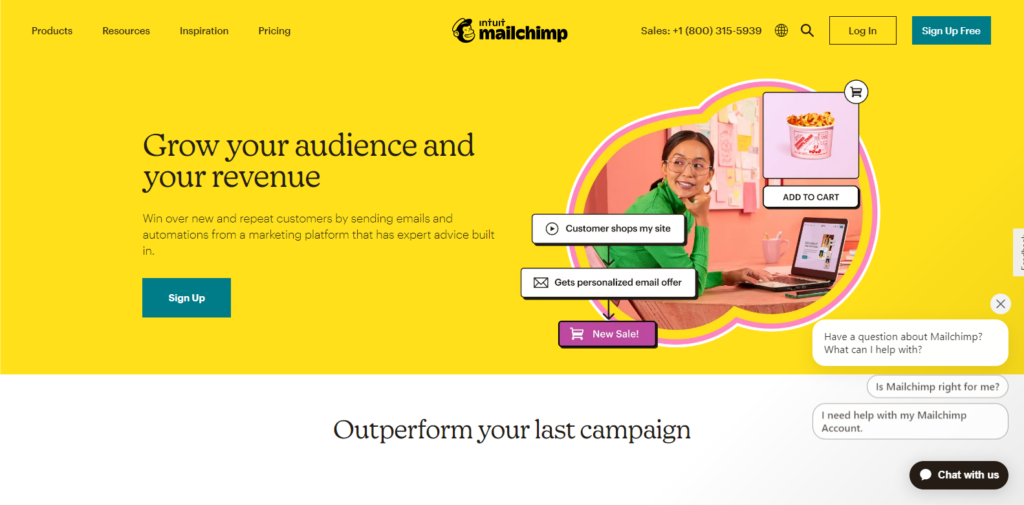
ActiveCampaign
As a CRM (customer relationship management system), ActiveCampaign helps customers with email marketing and other aspects of their digital marketing strategy. It includes email sign-up forms, split testing, and email segmentation in its packages. It may be more robust than a beginner email marketer needs, but it is worth looking into.
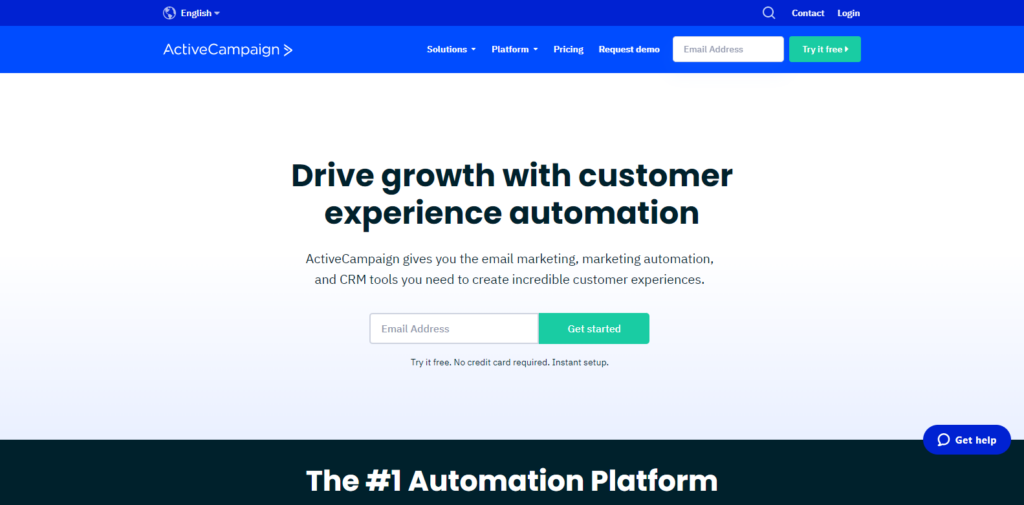
Flodesk
Visual content creators who want to stray from plain text emails and ditch the same-old-same-old can customize one of Flodesk’s many email design templates. Designed to fit mobile and desktop screens, Flodesk is a great option for brands that rely on graphics and visuals to sell their products or services. Learn more about their email platform here.
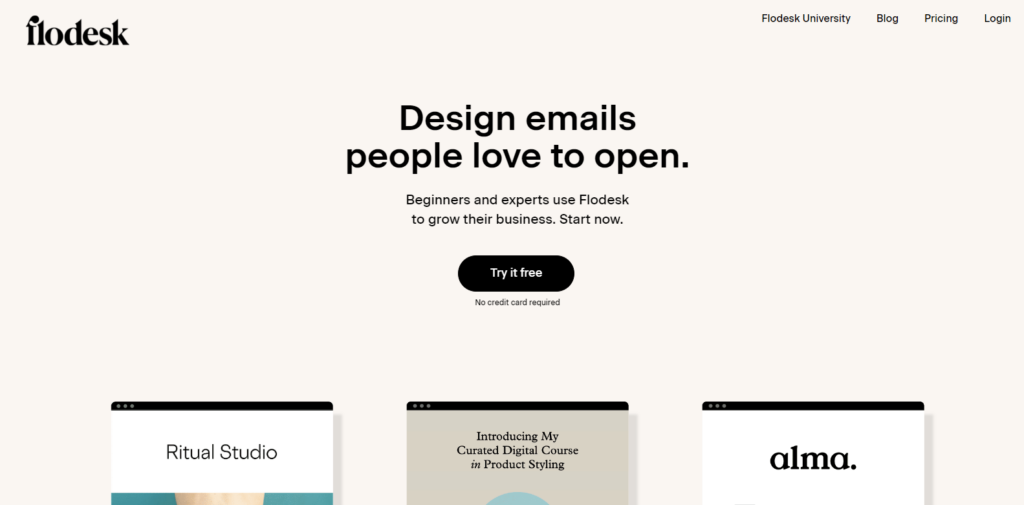
Drip
Specializing in e-commerce, Drip is a trusted CRM tool that includes email marketing as one of its many features. If you are looking to build an e-commerce shop to sell digital or physical products, Drip might be a fit for you.
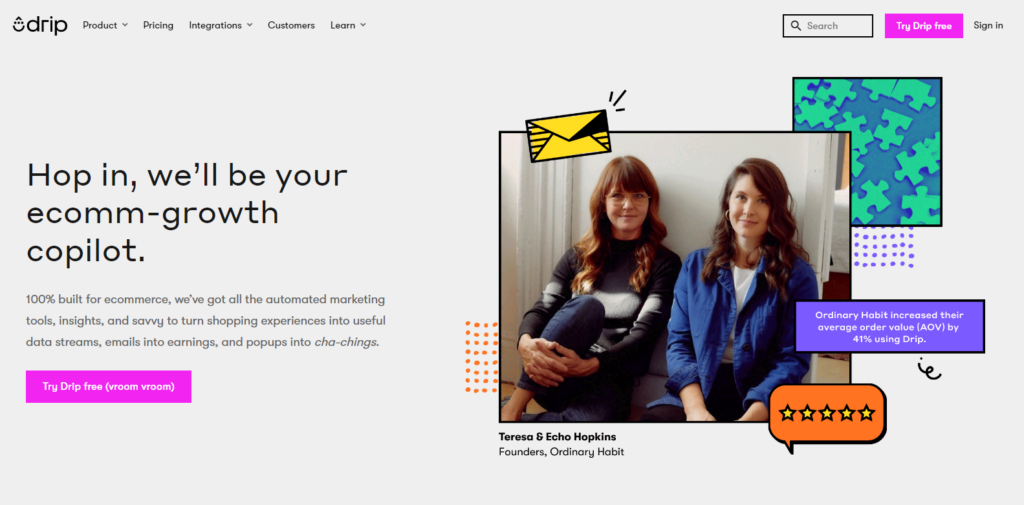
Once you determine which email marketing platform you want to use, you can focus on list building.
Hands down, the best way to grow your email list is to use lead magnets.
Use lead magnets to build your email list
A lead magnet refers to any incentive you give to your audience in exchange for their email address. This often comes in the form of a freebie or instant download but can also be a special discount or limited time offer.
Depending on your email list building goals, choose a lead magnet that educates your audience on a niche topic that’s relevant to one or more of your offerings.
There are dozens of lead magnet types you can use to build your email list, but here are some of our absolute favorites. I’m sure you’ll find a few that are worth putting into action on your website.
Email courses: Are you interested in teaching your audience about a specific topic that relates to your niche? Or giving your audience a challenge that helps them accomplish their goals? If so, an email course might be a great fit.
Not only will an email course get your audience used to opening emails from you but it will also engage them with your email content right from the start. By creating separate email lessons, you can use your mini-email course to share information that positions you as a trustworthy expert. These emails can be automated for hands-off delivery.
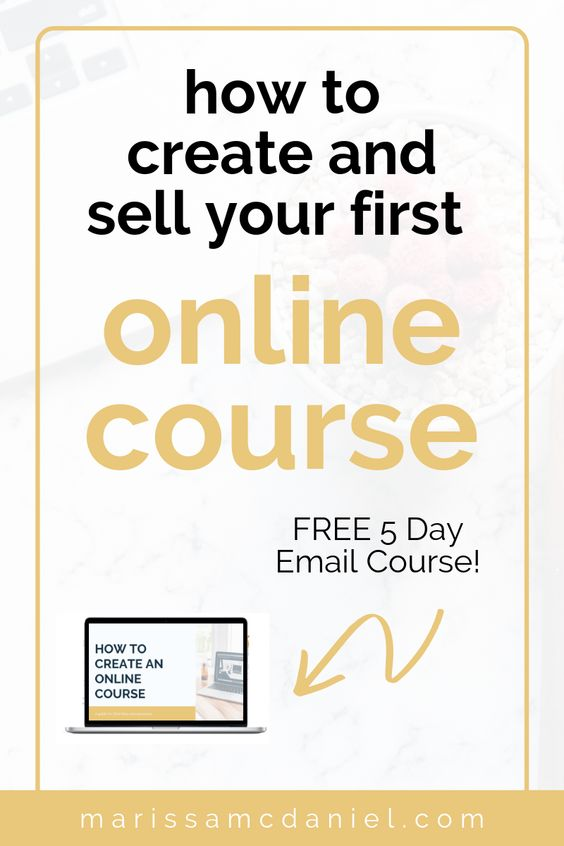
Ebooks: Ebooks are simple to create, especially when you are repurposing content. Use these downloadable freebies to write a valuable how-to guide that teaches your audience about a specific topic, tells a personal story, or shares a case study detailing how you helped a client achieve a specific transformation.
No matter what you use your ebook for, make sure it is packed with easily digestible, educational content: guides, checklists, cheat sheets, and other exclusive content that you wouldn’t normally post on your blog, for example.

Giveaways: Offering a free course, consultation, subscription, or just a coupon can be an easy way of gathering emails and staying top-of-mind. As a bonus, the winners will enjoy your services and later recommend them to their peers.
Host your giveaway on an independent landing page with all the details and policies. Don’t forget to include a list of terms and conditions to guarantee fair competition.
Add a unique tracking URL to the button people use to enter the giveaway. This will let you monitor who returns to your website, made a purchase, or shared an article from your blog.
Quizzes: For a fun, enjoyable, and highly interactive experience, create a personality quiz for your audience to take that helps them better understand themselves. When you aid in this self-discovery process, you build immediate trust with your audience members.
You can also add a follow-up email sequence to your Interact quiz to grow your email list and offer personalized recommendations for each personality type. This will help you position yourself as an expert and increase your overall conversions.
Your email sequence can be automated through your email service provider (we offer integrations with most email marketing tools), so it runs on its own after someone signs up for your email list through your Interact quiz.
You can start building your own quiz today by using one of our many quiz templates and signing up for an Interact account!

Webinars: Regularly hosting webinars provides a huge plus to your content marketing efforts. For one, they help you get email addresses of qualified leads who are likely to open and read your monthly newsletters.
Beyond this, they’re a chance of proving your thought leadership and getting the word out regarding a new course or service you offer. If webinars seem too complicated to host alone, try a live event like a Q&A session or a series of instructional presentations to raise awareness of a topic.
As a rule, try to host these on your website instead of YouTube or Facebook. This will help you get more backlinks to your domain and increase the time people spend on your website, strongly contributing to your SEO efforts and placing your website higher in Google’s search results.
Printables: Few things are easier to create and promote than a printable. Printables include checklists, workbooks, worksheets, spreadsheets, trackers, wall art, and more. You can create them using a free tool like Canva, which offers premade and customizable graphic design templates, so you don’t need to start from scratch.
Printables are high-quality content upgrades for blog posts, but they may not be strong enough on their own to become your signature lead magnet. Test this offering as you’re blogging to see how it performs.
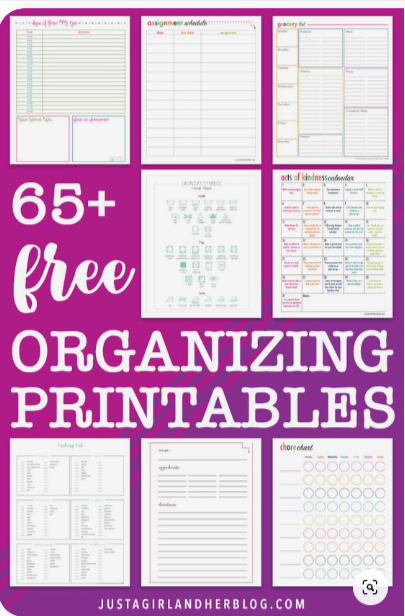
Templates: Along with printables, you can offer your audience a variety of templates that include premade and customizable designs or copy. Your audience can edit your templates to fit their needs rather than creating something from scratch. This is a high-quality lead magnet type for content creators and freelancers who are skilled in writing, design, photography, or any other related craft.
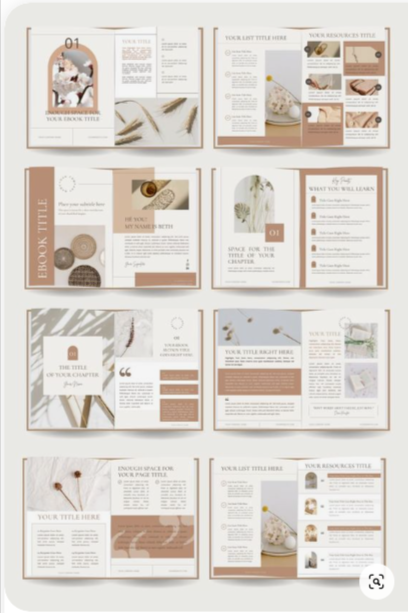
Discounts and coupons: When you offer a valuable discount, it’s almost guaranteed that prospects who are highly interested in your services will join your email list. To prevent people from spreading your discount codes online, create unique codes that can only be used once.
Coupons aren’t just for first-time buyers though. Consider offering discounts in the following scenarios, for example:
- To loyal clients who’ve purchased an item several times
- Free delivery on a future order
- During special events or holidays
- For referrals
But what are the best practices for email list building?
List building best practices
Once you have an idea of what kind of lead magnet you want to use, let’s go over some best practices and the final elements you need to create a strong list building strategy.
Stick to one main call-to-action
A call-to-action (CTA) refers to a direct action that you want your audience to take. In this case, you want to inspire your audience to sign up for your email list by using incentive and action-oriented language to get them to click your CTA button.
If you aren’t sure what words you should use in your CTA copy, look at the CTA word bank from CoSchedule (below) to get some ideas.

When you create your CTA, make sure that it is strong and points to only one action. If you give your audience too many options, they could develop analysis paralysis, which often causes people to not make a decision because they are presented with an overwhelming amount of options.
The more options your audience has, the less likely they will be to sign up for your email list. Focus your email sign-up form on one incentive or special offer to increase your email marketing conversions.
Take a look at these email sign-up forms. Instead of highlighting multiple lead magnets, the content creators included a single offer that fits their audience’s needs and makes it super simple to sign up.
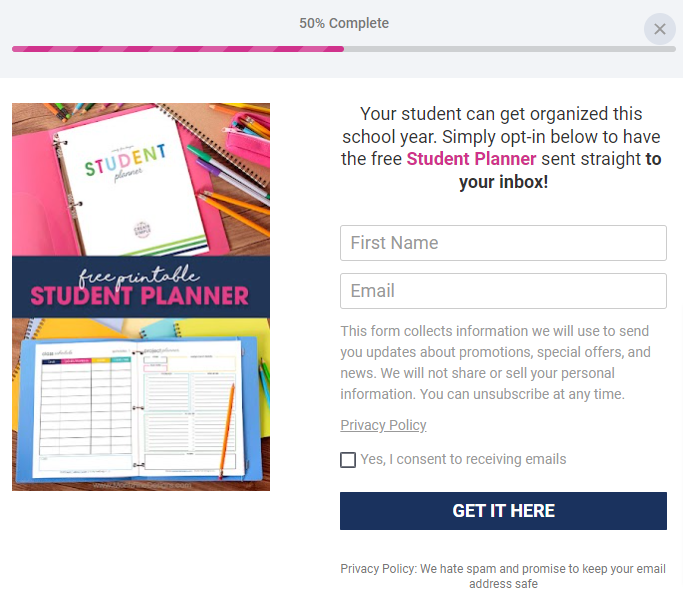
Do the same by choosing one goal for your email sign-up form and connecting it with one incentive. It can be a discount, special offer, or lead magnet that entices new subscribers to sign up. No matter what you choose, keep it specific to your primary offer.
Use email sign-up forms in multiple places on your website
If you plan to use only one email sign-up form on your website, you’ll seriously limit your opportunities to convert blog readers and website visitors into email subscribers.
Let’s say you decided to include an email opt-in form on your Home page. That’s a great place to build your email list with a lead magnet offer, but not everyone who visits your website will be coming from your Home page. Some people may visit your website through a specific landing page or blog post.
Optimize your whole website for the lead magnets and special offers that make the most sense for each page. As long as you stick to one CTA per page, you can sprinkle in multiple mentions of your email list offer.
Below is a great example of how this can work. When you first visit Eden Fried’s blog, you are greeted right away by an email sign-up form in her blog sidebar that offers a free download.
By giving her an email address, site visitors will immediately receive her Digital Product Roadmap. Her CTA is simple, and she strengthens the offer by noting that readers can generate their first $1,000 in just 90 days.
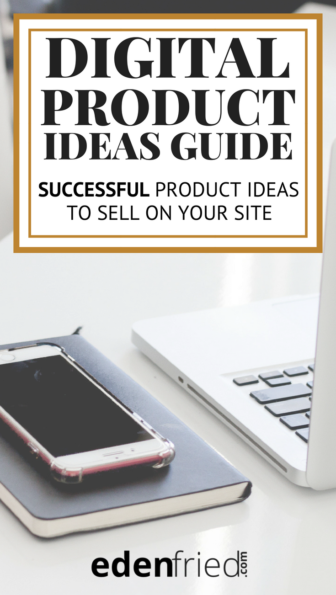
She has a yellow CTA button in her top navigation bar that says “Download First 1k,” which directs her blog readers to the same offer. She is definitely optimizing her website with this specific lead magnet.
She doesn’t stop there. Eden also includes an email sign-up form within the content of her blog post, pointing to the same offer.
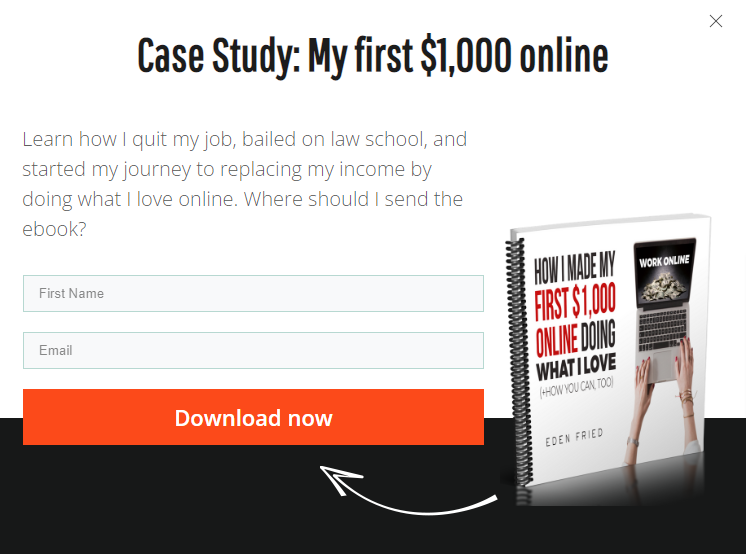
This time, Eden gives a visual screenshot of what the ebook cover design looks like to help her lead magnet stand out from the text content. The red CTA button makes a statement as her blog readers are scrolling through the article.
Notice the description copy is different from what you see on her blog sidebar. This distinction is important because when you are sprinkling mentions of the same offer throughout your website, you don’t want to use the same copywriting. Your audience will scroll right past the email sign-up form if they notice you are using duplicate content throughout your site.
The rest of her blog post focuses on the content topic until the end. When Eden concludes her blog post, she adds another email sign-up form for people who enjoyed her content enough to read the entire post.
This final email sign-up form is for blog readers who may have needed to read more of her content before trusting her enough to opt-in for the Digital Product Roadmap. She adds one last personal detail in the title of her copy: “How I quit my job and bailed on law school,” which will strengthen her relationship with new email subscribers.
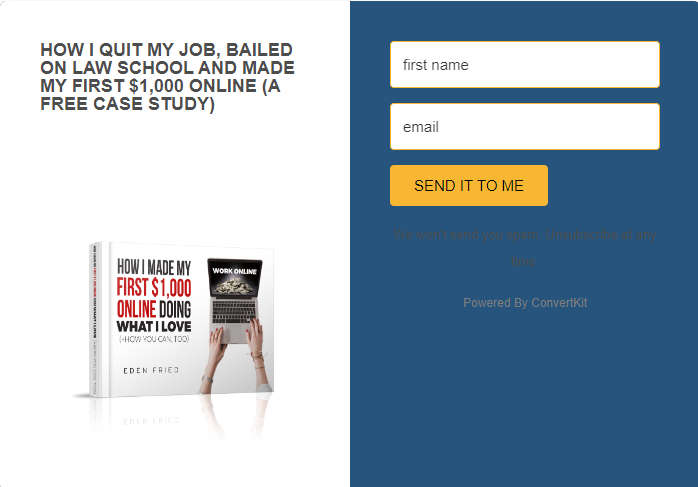
In summary, here is a comprehensive list of places on your website where you can place an email sign-up form to grow your email list:
- On your landing page
- In your website’s footer
- In your website’s navigation bar
- In your blog sidebar
- At the end of your blog post
- At the end of your About page
- Highlighted on your Home page
- On your Resources page
- Linked in your social media bio on networks like Twitter, LinkedIn, or Instagram (use a tool like Linktree)
- In a floating announcement bar (use a tool like Hello Bar)
So far, we’ve talked about static email sign-up forms (meaning forms that stay in one place), but what about other form types?
Email pop-ups
Love them or hate them, you’ve probably noticed that a lot of websites use email pop-ups to entice visitors to sign up for their email list. That’s because they work across many industries.
When Sumo analyzed nearly two million email pop-ups, they found that the average conversion rate for email pop-ups is around three percent, with the highest conversion rates being around nine percent. These conversion rates are relatively higher than most static email sign-up form types.

Before you test email pop-ups on your website, let’s go over some best practices:
- Give it time: Keep your email pop-ups time-sensitive to avoid turning off your audience. When they land on your website, they want to scroll through your content and interact with your design. If they are greeted by an immediate email pop-up form, you didn’t give them enough time to trust you with their email address. You can easily adjust the time settings for your email pop-up form and test it to find the optimal time for delivery.
- Add context: Clear, direct language is always best! Make sure your headline and description copy fully explain what your audience is signing up for. Set expectations by letting them know what they will receive. Your audience will feel more comfortable giving you their email address.
- Keep it focused: Are you tempted to give your audience multiple offers? While it may seem like a good idea at the moment, remember to keep your email pop-up focused on one main CTA.
- Match the branding: Does your email pop-up design match your visual branding guidelines? Does your copywriting fit with your brand voice? Make sure your email pop-up seamlessly integrates with the rest of your website content and design.
- Add a sense of urgency: The basics of sales copywriting tell us that when we add a sense of urgency to our email opt-in, people are more likely to sign up. Nobody wants to miss a discount or special one-time offer. The important thing to remember when you use urgency to increase your email conversions is that the offer is actually for a limited time. If it’s not, your audience may feel taken advantage of. To use urgency ethically, your claims must be true. You wouldn’t want to gain someone’s email address but then lose their trust in the process.
- Highlight your personality: Your email pop-ups are a great place to add humor, pop culture references, catchphrases, or other words that fit your brand voice. Just make sure that your message is clear and humor doesn’t feel forced.
If you’re excited about testing email pop-ups for your email list building strategy, you’re probably wondering what kind of pop-up you should start with.
A standard email pop-up typically opens after a certain length of time and shows up in the middle of the visitor’s screen. It can include a special offer, lead magnet, or discount to sweeten the deal and convince visitors to sign up.
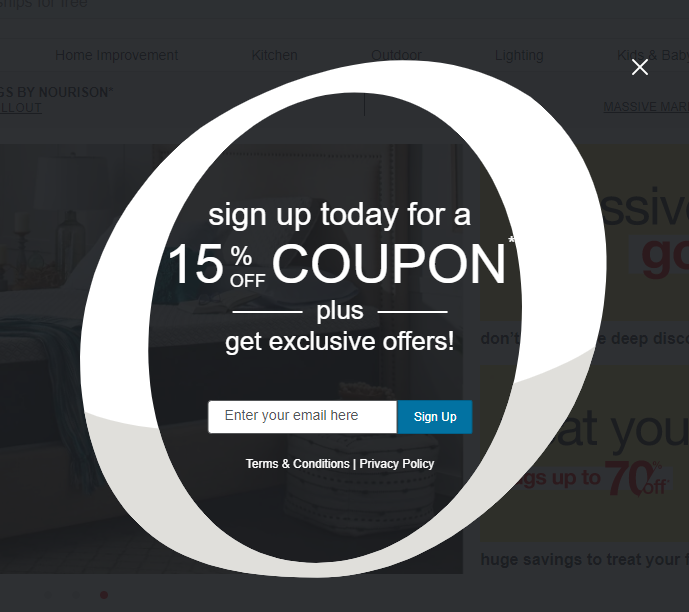
You may have noticed that some email pop-ups cause website backgrounds to darken. This is so the visitor can focus on the pop-up offer, without being distracted by the website page.
Make sure the email pop-up form is designed to fit both mobile and desktop devices. If it doesn’t have a responsive design that fits any device screen, you’ll have a hard time attracting new email subscribers.
While the standard email pop-up form stays front-and-center, there are a few other places you can place an email pop-up form, like the bottom of your website page.
As a visitor scrolls through your page, the sliding email pop-up form will activate. You can include an exit button for visitors who aren’t interested in signing up, so they still have a seamless user experience, just like Aerie in this example.

Another option is to create an email pop-up form that slides from the top as a visitor scrolls past the header on your website. Jeff Bullas, a popular internet marketing blogger, does this to build his email list with an ebook lead magnet.
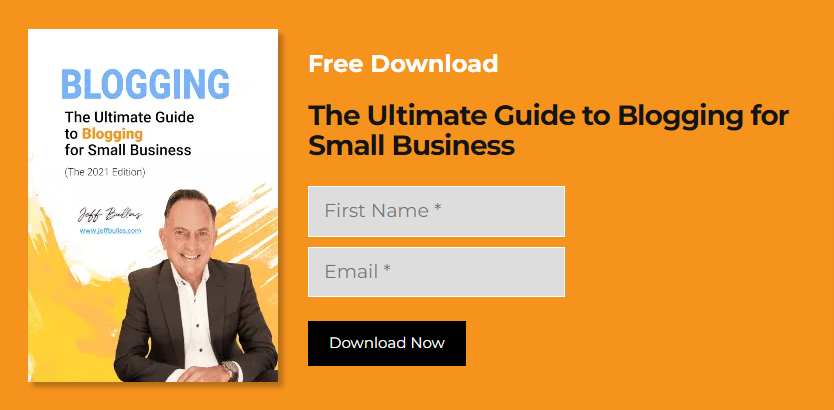
Want to save on space? Use an email pop-up form that slides in from the left or right side when activated by the visitor’s scroll. The sliding motion will guide their eye to the email incentive offer.
This works well when you are creating long-form blog content and want to keep your audience’s attention as they read through your article. You can follow this example from Hubspot to see what we mean.
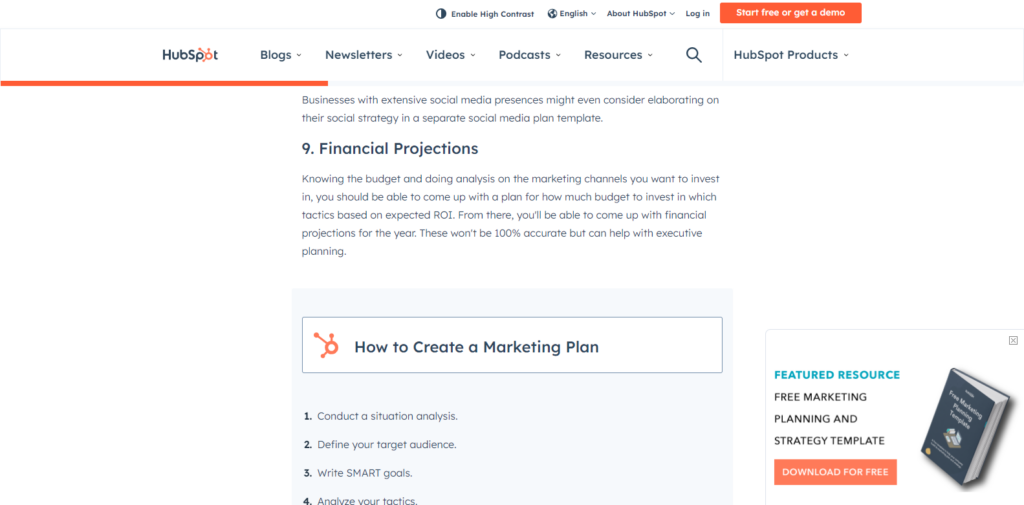
The last option is to create an exit pop-up form that shows up on your audience’s screen when they are just about to leave your website. Triggered by your audience’s moving cursor, an exit pop-up will give your audience a limited time offer or remind them of the lead magnet they can sign up for before they leave.
Once you’re ready to create email pop-ups, test different variations to find the best performing version. Here’s what you should know about A/B testing your email sign-up forms.
Test your email sign-up forms
You may be tempted to think your form is fine as it is, but to increase your email sign-ups, you’ll need to test your email opt-in form.
Sometimes a few strategic tweaks make all the difference when you measure the performance of your email sign-up forms.
Here are the different variables you can test:
- Form design (color, contrast, fonts, etc.)
- Form copy (CTA button, headline, description, etc.)
- Form offer (lead magnet, special offer, discount, etc.)
- Form fields (how many form fields, what form fields you use, etc.)
When you create an A/B test, you’ll measure two different variations of an email sign-up form to see which one performs the best (i.e., which one received the most email sign-ups).
The key to creating a great A/B test is to change only one element at a time. If you rewrite the copy on the entire form, you won’t know if it was the new headline or the new CTA button that changed the results.
When ConversionXL tested their CTA button, they ran a red and green color, but used identical copy. When the test results came back, they saw that the red button increased conversions by 34 percent.

In the below A/B testing experiment, the test simply changed “your” to “my” in the CTA button. It may seem like too small of a detail to test, but the results say otherwise. The “Create My Account” button outperformed the other version by nearly 25 percent.
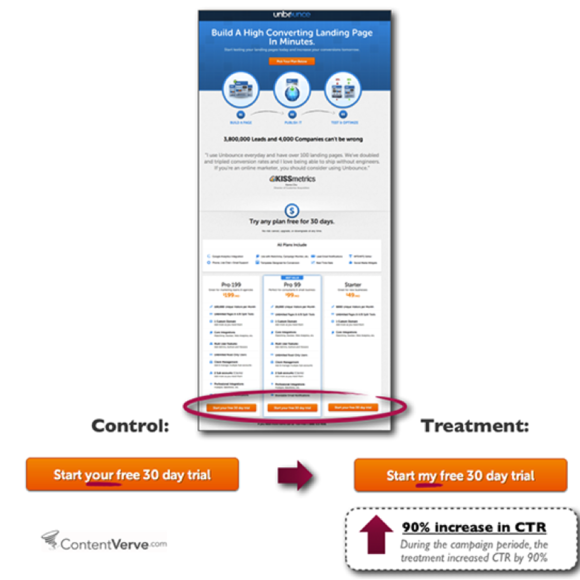
To complete your own A/B test, look into tools like LeadPages, OptinMonster, or Hubspot (which will integrate with your Interact quiz) to create A/B test variations that fit your needs. Your email service provider may also provide A/B testing options, so contact them for details.
4 email marketing templates you’ll need to build an email list
You know what works (and what doesn’t) when list building, but now you need to put it into action.
We’ve talked about creating email sign-up forms and using lead magnets to grow your list, but how in the world do you get started?
Well, you don’t have to start from scratch. If the blinking cursor is giving you major anxiety, use our email marketing templates to help create everything you need to get started with list building.
No, really. We mean everything.
At Interact, we provide totally customizable templates for the following:
- Email sign-up forms
- Thank you pages
- Lead magnet delivery emails
- Welcome email sequences
Ready to get started?
Email sign-up form copy template
Below I’ll focus on template copy, but for now, let’s briefly chat about your email sign-up form design.
The visuals you use on your form matter to your audience. Don’t believe us? What if we told you that 92 percent of people make purchasing decisions based on visuals? That’s huge!
Most ESPs will let you customize your email opt-in form design within their platform. Make sure that your colors and fonts match your visual branding when possible. Keep in mind that some colors are better for conversions than others.
Here are a few best practices for design:
- Choose your CTA button color wisely. Make sure it stands out and highly contrasts with the other colors on the form.
- Add a photo preview of your lead magnet when possible. It will help your audience familiarize themselves with the design and know what to expect. This visual lead magnet sneak peek will also make it seem more valuable, enticing your audience to fill out your form.
- Add a colored background to make your email sign-up form stand out. It will surely catch your audience’s attention among all the white space on your website.
- Create a statement with your headline style. You can do this by putting your headline in bold or italics, increasing the font size, or writing it in a signature font.
As you play with the design of your email sign-up form, you’ll naturally be thinking about the copy you want to include. Hopefully you’ve found some inspiration in this article, but here are a few copy templates you can customize as well. I’ll use three of the most common lead magnet types as examples.
You can easily fill in the blanks when you’ve narrowed down what your lead magnet is, what you are teaching or sharing, who you are offering it to, and why they should care.
Email Marketing Template: Email Sign-Up Forms
For Quizzes:
Headline: What Kind of [Blank] Are You?
Description: Discover your [Blank] strengths and how you can strategically use them to accomplish [Blank] by taking my personality quiz!
CTA Copy: Take the Quiz, Start the Quiz
PS: If you want to start building your own quiz to massively grow your email list, click here to sign up for a free trial with Interact! You’ll be able to customize your quiz right on the platform and start collecting new qualified leads like so many other content creators in our community.
For Email Courses:
Headline: Become a [Blank] Pro in [Blank] Days
Description: Learn exactly how I went from [Blank] to [Blank]. In [Blank] lessons, I’ll show you how to accomplish the same thing!
CTA Copy: Sign Me Up, I Want to Join
For Downloadables:
Headline: What If You Could [Blank]?
Description: In this [Blank] page guide, you’ll learn step-by-step how to [Blank] so you can [Blank] like the experts!
CTA Copy: Download Now, Get My Copy
No matter what lead magnet type you choose, use this template to create an email sign-up form copy that gets your audience to take action.
Your headline should be concise but impactful. Your description, however, should be one or two short sentences that describe what the lead magnet’s benefits are and what your audience will walk away with. That’s more important than pointing out the features of the lead magnet. (This is a good rule to remember for other types of copywriting, too!)
As long as your CTA button copy describes what action your audience should take next and doesn’t include the overused word “Submit,” you’ll be set to go.
If you decide to create a landing page for your lead magnet instead of a simple email sign-up form, you can use the same copy templates.
If you have more room in the description, consider writing a bulleted list of what your audience will learn and gain from the knowledge you’re sharing through the lead magnet.
Thank you page copy template
Once someone signs up for your lead magnet, then what?
Most content creators forget this important next step. After someone signs up for your lead magnet, your ESP will most likely show a generic message like “Thank you for signing up! Check your email inbox shortly.” But that doesn’t provide a great user experience.
Instead, redirect new email subscribers to a dedicated Thank You page on your website. It should be relatively short, including only the necessary details. Let’s go over each one and take a peek at some examples.
- Add a personal thank you message. Someone just joined your email list. That’s a big deal! Use this page to thank them. You can have fun with the copy, depending on what your brand voice allows. You can also confirm here that they will soon receive the lead magnet they signed up for.
- Set expectations. After you say thank you, use this page to set expectations for when your audience can expect to hear from you. Do you send weekly or monthly emails? Do you send them on a certain day or time? What kinds of topics do you typically discuss? All of this information is valuable to your audience.
- Direct them to their email inbox. Before you sign-off, ask them to check their inbox for their lead magnet. You can also ask them to add your email address to their Primary email folder so there’s no risk your emails will be marked as spam.
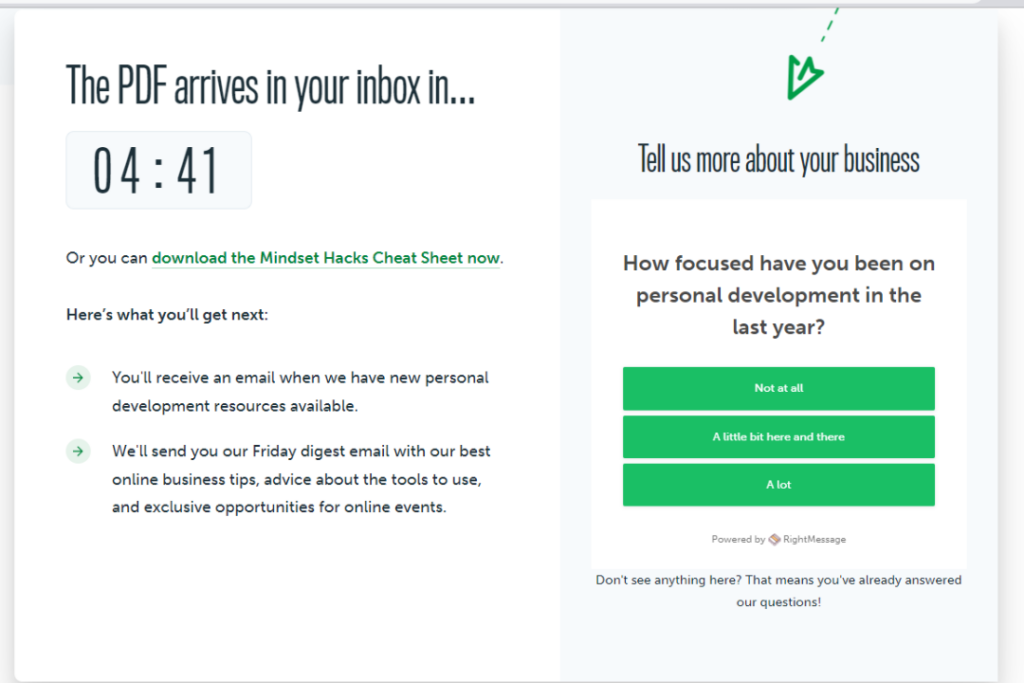
These next Thank You page recommendations are totally optional but we still love them!
- Add a recommended resource list. Link to blog posts, podcast episodes, or videos you’ve created that might be a fit for subscribers. (If you create an Interact quiz as a lead magnet, you could also include recommendations for each personality type to further nurture your leads. They’ll be so impressed!)
- Add social share buttons. Your new email subscribers might know other people in their network who would love your lead magnet. By including social share buttons on your Thank You page, your audience can share your lead magnet offer with their community, which increases its reach.
- Add a personal photo of yourself. Few things help your audience build a stronger connection with your brand more than seeing the face behind it. If you are branded under a company name, show a photo of your team or share a personal headshot of yourself. Professional brand photography works best here, but you can also add illustrations if that’s more your style.
- Add a secondary CTA. Once you have your audience’s attention, make use of it! Lightly introduce one of your other offerings or ask if these new leads would like to sign up for a discovery call. You can decide if this added CTA feels like a fit.
Now it’s template time! You know the essential components of a great Thank You page, so now let’s put one together with simple, memorable copywriting.
Email Marketing Template: Thank You Page
Headline: Your [Blank] is on the way!
Description: Thanks for signing up for [Blank] and joining my email list community. I send weekly emails every [Blank] on topics like [Blank] and [Blank], so keep an eye out. For now, check your inbox to get the [Blank] you signed up for, and be sure to whitelist my email address so you never miss an email. I’ll meet you over there!
If you want to include additional resources, CTAs, or copy, you can do so on your own Thank You page.
Just remember not to put too much information on this page and run the risk of overwhelming your new email subscribers. You’ll still have plenty of time to build a strong connection with them through your email marketing.
In the meantime, focus your efforts on creating a concise Thank You page that thanks your new subscribers for joining your email list, briefly gives them the information they need, and directs them to where they need to go next. It’s really that simple!
Lead magnet delivery email copy template
Once your audience reads your Thank You page, their next step will be accessing your lead magnet from their email inbox. Since most lead magnets are automatically delivered by your ESP, it’ll show up within minutes (or even seconds!) of someone signing up.
Keep in mind that some ESPs recommend you create a double opt-in option for your email list, meaning that once your audience signs up for your email list through a form, they will be prompted again by email to confirm they want to join your list.
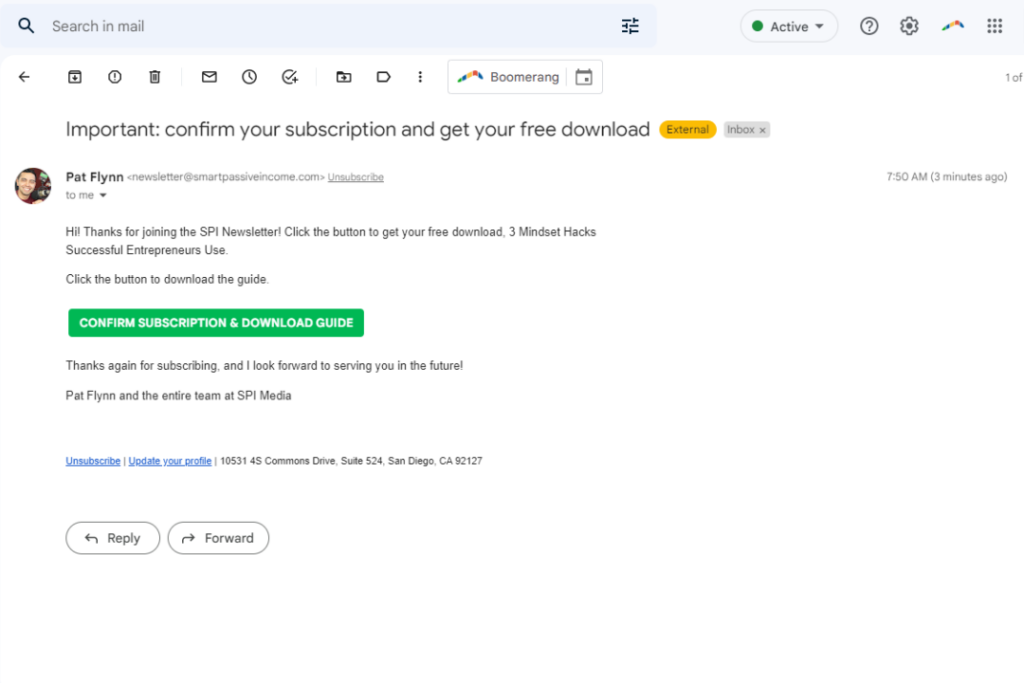
This double opt-in option allows you to make sure everyone who signs up for your email list truly wants to join, which will reduce spam emails and help you comply with GDPR regulations. It requires one more step from your audience, but after they click the confirmation button, they will receive your lead magnet delivery email.
This is likely the first email your audience will receive from you, so make it count by including more than a link to your lead magnet. Think about how boring it would be to open your inbox and find a download lead magnet button with no other information. #snore
When you are crafting your lead magnet delivery email, make sure it includes these core elements:
- Friendly subject line: Before your new subscriber opens your email, they will see the subject line. Think about what kind of email subject lines would entice you to open an email. Remember, it’s more important to be clear than clever; this is a good place to reiterate what lead magnet you are sending so subscribers know exactly what they’ll find when they open your email. Some ESPs like ConvertKit and MailChimp let you A/B test subject lines so you can see which variation performs best.
- Thank you message: Even though you already wrote a Thank You page, use this opportunity to thank your subscriber for not only downloading your lead magnet but also signing up for your email list community. You can never say thank you too many times.
- Lead magnet reminder: Even though you mention what the title of your lead magnet is in the email subject line, it’s best to include it again in the body text of your email. Then point your subscribers to your CTA button where they can download the lead magnet. If your lead magnet is not downloadable, include your first email course lesson or give more information about the person’s quiz personality.
- Explain the “why” behind your lead magnet: After the CTA button, describe what your audience can do with the lead magnet and why they should care. Even though they’ve already signed up for the lead magnet, make sure they actually consume it. Otherwise, it’ll just sit in their inbox or their Downloads folder. That’s not helpful for you or them.
- Before you sign off, ask your new subscriber for feedback on your lead magnet. What lessons or advice did they take away from it? What was most helpful to them? This will help you improve your lead magnet over time while also introducing you to your new subscriber. Win-win!
All of these elements can be seen in the email marketing template below.
As you customize it to fit your lead magnet, remember to keep it relatively short and sweet. You have plenty of time to share more of your personal story and highlight your expertise in the emails to come. Hang tight because we’ll be giving you a template for a simple follow-up email sequence too!
But first, here is a template to help you create a lead magnet delivery email your audience will be excited to open.
Email Marketing Template: Lead Magnet Delivery Email
Email subject line: Your [Blank] guide is inside!
Hi [Blank],
I have a special delivery for you today!
Remember when you signed up for my [Blank] guide and got really excited to check your email inbox? Now that you’re officially a part of my email community, I’m sending over all of my best resources, starting with [Blank].
CTA Button Copy: Click here to download [Blank]
After [Blank] years of experience, I’m sharing everything I know about [Blank] through this [Blank] guide.
Whether you are [Blank] or [Blank], I hope that this [Blank] guide gives you the advice you need to achieve [Blank]. Ready to get started? Simply click the button above to instantly access the [Blank] guide.
You’ll hear a little bit more about my story soon, but for now, I want to hear from you!
Tell me a little about yourself and what you learned from [Blank] guide. I personally reply to every subscriber, so you can expect an email reply from me soon.
Thanks again for joining my email community, and I hope you enjoy [Blank]!
Best,
[Blank]
Now you’re ready to create the last piece of content you’ll need for your email list building strategy: an engaging welcome email sequence.
Welcome email sequence copy template
Your subscriber has already received your lead magnet delivery email and confirmed their subscription. Now it’s time to nurture your relationship with them by sending a short email series that will introduce them to your brand.
The main goal of your welcome email sequence is NOT to sell a product or service. Instead, you’ll want to use these first few emails to make a personal connection with your audience while educating them on a topic of your choice.
If you lead with a pitch, you might turn off your new subscriber. It’s like going to a networking event and giving someone your business card before you describe who you are and how you can help them. This approach can feel jarring and disjointed.
Your email subscriber’s inbox is probably already full of sales pitches. Stand out by investing in the relationship first.
To make a confident purchasing decision, your audience needs to feel like they can trust you. They want to buy from or work with an expert, and it takes time to build your authority and credibility. A welcome email sequence is a perfect place to begin nurturing.
Who knows? Your next client or buyer could be reading your follow-up email sequence soon.
So let’s make sure you make a great first and lasting impression.
Your email sequence content will largely depend on what type of lead magnet you choose, but we’ll help you plan your welcome email sequence with an in-depth outline.
Email Marketing Template: Welcome Email Sequence
Email 1: Personal Welcome + Introduction
Hi [Blank],
What do [Blank], [Blank], and [Blank] all have in common?
These three things don’t seem similar at first glance, but they all would make it onto my favorite things list!
As a [Blank] expert, I’ve always been fascinated with [Blank] and [Blank].
There are few things that get me more excited than [Blank] and [Blank].
But where are my manners?
I forgot to introduce myself!
Hi, I’m [Blank], a [Blank] for [Blank] people who want to achieve [Blank].
After working with [Blank] clients, I’ve learned the importance of [Blank] and [Blank]. That’s why I love working with [Blank] people just like you on [Blank].
When I’m not working, I’m usually [Blank] or [Blank], which is probably not that surprising after hearing about my favorite things list.
Hey, that reminds me… What would make it onto your list? I want to hear about it. Simply hit the reply button and tell me more about yourself.
I feel like we are friends already.
Now that you know a little more about me, stay tuned next week for some of my best tips on [Blank] – you won’t want to miss it!
Chat soon,
[Blank]
Email 2: Tips + Tricks on Your Topic
Hi [Blank],
It can be tough when you want to learn more about [Blank] but aren’t quite sure where to start.
Maybe you’ve tried [Blank], but it only leaves you wondering about [Blank]. Have you also tried [Blank]? Well, that probably didn’t get you anywhere either.
Something’s gotta give!
Instead of looking at [Blank] resources that are only skimming the surface of what you want to learn, how about we start with a lesson on [Blank]?
I wish I would have known these tips when I got started with [Blank] over [Blank] years ago. It would have saved me so much time and energy!
I want to pay it forward today by giving you my best advice on [Blank] so you can approach it like a pro the next time you [Blank] or [Blank].
You might want to get a pen and paper. These notes are about to get good!
POINT 1
POINT 2
POINT 3
Which tip is your favorite? Let me know by hitting the reply button and telling me how you are going to put your favorite tip into action this week.
Chat soon,
[Blank]
Email 3: Personalized Recommendations
Hi [Blank],
Now that you’re armed with my best tips on [Blank], you probably want to do something with all this new knowledge. Where in the world do you start?
That’s why I’m here.
Consider me your trusted guide in all things [Blank] and [Blank].
Now that I know you are interested in [Blank], you’ll be looking to put your [Blank] and [Blank] skills to the test. Here are a few hand-picked resources to help you along the way.
RESOURCE 1
RESOURCE 2
RESOURCE 3
I have many more resources to come, but for now, these are a great place to start to learn more about [Blank].
If you are looking for more information, you can always check out my blog at [Blank] or follow along with my latest tips on social media at [Blank].
Until next time,
[Blank]
(PS: If you want to see multiple real-life examples of how this email sequence can come together, take a peek at our blog post on How to Write the Perfect Follow-Up Email Sequence. It uses quiz-specific examples, but you can use the same ideas for any lead magnet type.)
That email sequence basically wrote itself!
Fill in the blanks to customize your email sequence to your audience, and it will be ready for your lead magnet marketing campaign.
Next steps for list building like a pro
You now have all of our email marketing templates and best tips for creating a winning list building strategy—now we have a challenge for you!
This week, we encourage you to create ONE list building resource to grow your email list. You can use any of the templates we’ve shared to get started.
If you are an overachiever (which we know you are), choose all four. You can create them over a weekend or fit the work into one-hour time blocks during the week. It is worth fitting list building into your schedule.
So, who’s ready to start building their email list?

